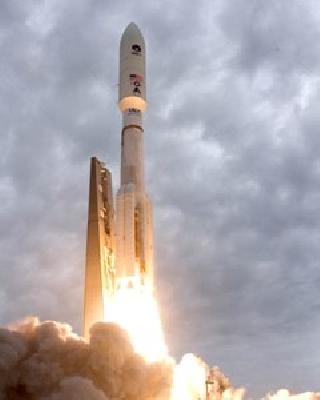
ULA Atlas V launches with MUOS-2 satellite (photo credit ULA). Photo: Lockheed Martin
CAPE CANAVERAL AIR FORCE STATION, FLORIDA (BNS): The second Mobile User Objective System (MUOS) satellite built by Lockheed Martin for the US Navy is responding to commands after being launched on Friday.
MUOS-2 launched at 9:00 a.m. EDT aboard a United Launch Alliance Atlas V rocket and will transition over the next nine days to reach its geosynchronous orbit location 22,000 miles above the earth.
The solar arrays and antennas will then be deployed, and on-orbit testing will start for subsequent turn-over to the Navy for test and commissioning to service, Lockheed Martin said.
The Lockheed Martin-led initialisation team is now commanding the satellite from the Naval Satellite Operations Centre located at the Naval Base Ventura County, Point Mugu, California.
The MUOS constellation replaces the legacy Ultra High Frequency (UHF) Follow-On system and delivers secure, prioritised voice and data communications, a first for mobile users who need high-speed mission data on the go.
The first MUOS satellite, launched in 2012, has been providing high quality legacy voice communications for users, and terminals are already testing using the advanced payload that enables data exchanges.
More than 20,000 existing terminals are compatible with and can access the MUOS legacy payload, and with the release of the new waveform developed for increased data-handling capacity, many of these terminals can be retro-fitted to access the Wideband Code Division Multiple Access (WCDMA) payload.
This advanced WCDMA payload incorporates commercial technology designed to provide 16 times the number of accesses above requirements for the legacy UHF Follow-On system. The satellites also include a hosted legacy UHF payload that will be fully compatible with the current ultra-high frequency system and legacy terminals.
The geosynchronous constellation consists of four satellites and one on-orbit spare, which are expected to achieve full operational capability in 2015, extending UHF narrowband communications availability well past 2025.
"MUOS is providing capability for mobile users that never existed before," said Iris Bombelyn, Lockheed Martin vice president of Narrowband Communications.
"We look forward to testing and delivering the second satellite of the MUOS constellation to our Navy customer. This on-orbit testing will prove the MUOS system capabilities and allow us to deliver the full suite of services available through the MUOS payloads, on MUOS-1 as well as MUOS-2."
 Previous Article
Previous Article Next Article
Next Article













The Indian Air Force, in its flight trials evaluation report submitted before the Defence Ministry l..
view articleAn insight into the Medium Multi-Role Combat Aircraft competition...
view articleSky enthusiasts can now spot the International Space Station (ISS) commanded by Indian-American astr..
view article